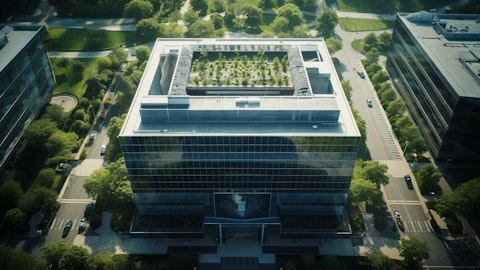Park-Ohio Holdings Corp. (NASDAQ:PKOH) Q2 2025 Earnings Call Transcript August 8, 2025
Operator: Good morning, and welcome to the Park-Ohio Second Quarter 2025 Results Conference Call. [Operator Instructions] Today’s conference is also being recorded. [Operator Instructions] Before we get started, I want to remind everyone that certain statements made on today’s call may be forward-looking statements as defined in the Private Securities Litigation Reform Act of 1995. These forward-looking statements are subject to risks and uncertainties that may cause actual results to differ materially from those projected. A list of relevant risks and uncertainties may be found in the earnings press release as well as in the company’s 2024 10-K, which was filed on March 6, 2025, with the SEC. Additionally, the company may discuss adjusted EPS, adjusted operating income and EBITDA as defined on a continuing operations or consolidated basis.
These metrics are not measures of performance under generally accepted accounting principles. For a reconciliation of EPS to adjusted EPS, operating income to adjusted operating income and net income attributable to Park-Ohio common shareholders to EBITDA as defined, please refer to the company’s recent earnings release. I’ll now turn the conference over to Mr. Matthew Crawford, Chairman, President and CEO. Please proceed, Mr. Crawford.
Matthew V. Crawford: Thank you very much. Welcome. Thank you for joining us this morning. We are very proud of the accomplishments during the second quarter. The strength of our business model is the broad and diverse nature of our businesses, combined with our strong operating leadership. Additionally, our transformation over the last several years is, and will allow us to be more profitable through the business cycle. Most importantly, we stand ready to absorb improving backlogs and new business with meaningful operating leverage. We believe strongly that the remainder of 2025 will continue to provide solid performance while building momentum for an even stronger 2026. Thank you, especially to all of our Park-Ohio team members. I’ll now turn it over to Pat.
Patrick W. Fogarty: Thank you, Matt. Before I get into the details of our second quarter results, I want to discuss a few recent events. First, we recently refinanced both our senior notes and our revolving credit facility. As it relates to the senior notes, we completed a private offering of $350 million of senior secured notes due in 2030, which bear an interest rate of 8.5%. We used the net proceeds from the offering, along with cash on hand to redeem all $350 million of the senior notes, which were due in 2027, and to pay related fees and expenses. In addition, we entered into an amendment to our existing revolving credit facility, extending its maturity date by 5 years. In connection with these refinancing activities, we received upgraded ratings on the new senior secured notes from Moody’s, S&P Global and Fitch Ratings.
In addition, many institutional investors continued their support of Park-Ohio, which led to the successful completion of the refinancing. We appreciate their commitment and continued support. These actions provide us with the future liquidity to execute our long-term goals, which include sales growth, higher operating margins and reduced net debt leverage. And lastly, our capital equipment orders in the second quarter were approximately $85 million, an all-time quarterly record and included an order from a major steel producer totaling $47 million for induction slab heating equipment for high-silicon steel production. The order demonstrates our ability to utilize our world-leading technology to engineer and manufacture high-tech induction heating and melting solutions for our customers.
The new order, which will ship from our Warren, Ohio facility beginning in 2026, enables the most uniform heating profile available in today’s markets. Turning now to our second quarter results. Second quarter revenue totaled $400 million compared to $405 million last quarter and $433 million last year. The year-over-year decrease reflects lower customer demand across certain end markets, most notably in our Supply Technologies segment in certain North American industrial markets. We took numerous countermeasures in each segment to enhance profitability, including variable cost reductions to align with current demand, targeted restructuring activities and reductions in discretionary spending. As a result of these actions, profitability improved on a sequential basis in the second quarter compared to the first quarter with adjusted EPS increasing 14% to $0.75 per diluted share and EBITDA as defined, increasing 4% to $35 million.
The sequential profit improvement was driven by higher gross margin percentage in the second quarter of 17% compared to 16.8% last quarter and 16.9% a year ago. We continue to focus on gross margin improvement through the implementation of value driver initiatives in each business. We generated $35.2 million of EBITDA in the quarter, an increase of $33.9 million in the first quarter. As a percentage of sales, our EBITDA margin was 8.8% in the quarter. On a trailing 12-month basis, our EBITDA as defined totaled $144 million. SG&A expenses were $46.8 million in the quarter, down from $47.4 million last year and $48.2 million last quarter, reflecting our cost containment efforts. Interest costs totaled $11 million during the quarter compared to approximately $12 million last year, driven by lower average interest rates in the current year and lower average outstanding debt balances.
Our effective income tax rate was 17% in the quarter, which reflects the ongoing benefits from research and development tax credits and other tax planning initiatives to reduce our overall effective tax rate worldwide. As a result, we have lowered our expected full year effective tax rate to range between 17% and 19% to reflect the impact of these tax strategies. During the quarter, we used operating cash of $14 million, primarily driven by higher working capital and CapEx, including technology-related investments and growth CapEx in multiple businesses. We expect significant operating and free cash flow in the second half of the year, driven by increased profitability and reduced working capital levels. For the full year, we continue to expect higher year-over-year free cash flow and expect free cash flow to be approximately $20 million to $30 million.

Free cash flow during the second half of the year is expected to significantly improve and total approximately $65 million. Our liquidity continues to be strong and totaled $189 million as of June 30, which consisted of approximately $46 million of cash on hand and $143 million of unused borrowing capacity under our various banking arrangements. Turning now to our segment results. Supply Technologies net sales of $187 million in the second quarter approximated our first quarter net sales and were lower than net sales in the prior year quarter due to lower customer demand in certain key end markets, including power sports, heavy-duty truck and industrial equipment, partially offset by increases in the electrical and semiconductor end markets.
Geographically, sales in Europe were stronger year-over-year, which was more than offset by lower sales in North America and Asia. Sales in our fastener manufacturing business were down year-over-year, reflecting lower auto production during the quarter. Adjusted operating income in this segment totaled $17 million compared to $19 million last year. Adjusted operating margins were 8.9% in the quarter compared to 9.5% a year ago due to the lower sales levels. On a year-to-date basis, sales in the segment were $375 million and operating margin was 9.1% compared to 9.6% last year. Operating margins above 9% in this business are at historically high levels, and we expect continued efforts to increase our margin profile in this segment by implementing operational improvements to drive growth and profitability, including investments in technology and warehouse optimization.
In our Assembly Components segment, sales in the quarter were $95 million compared to $103 million a year ago. The year-over- year decrease in sales was driven by lower unit volumes in our fuel rail and extruded rubber products, customer delays on new product launches across several automotive platforms and favorable pricing that ended in 2024, on certain legacy programs. Segment adjusted operating income of $6.1 million increased sequentially from the first quarter and was lower than the second quarter of last year due to the lower sales levels. In this segment we continue to win new business as over $50 million of incremental business across all product lines will begin to launch in the second half of this year and throughout 2026. The incremental business will positively impact future sales and margins in this segment.
In our Engineered Products segment, sales were $118 million compared to $127 million a year ago due primarily to lower sales in our Forged and Machine Products Group, driven by lower railcar demand and closure of a small manufacturing operation last year. In our Industrial Equipment Group, sales were similar year-over-year as aftermarket sales continue to be strong and production of new capital equipment stable in most of our global locations. During the second quarter, new equipment bookings were at an all-time quarterly high and totaled $85 million, which was driven by the one equipment order totaling $47 million that I mentioned earlier. Our capital equipment backlog continues to be strong, totaling $172 million, an increase of 19% compared to backlogs at the end of last year.
During the quarter, adjusted operating income in the segment was $6.4 million compared to $7.3 million a year ago. The decrease in profitability year-over-year was driven by the lower sales in our Forged and Machine Products Group. Year-to-date, net sales in this segment were approximately $240 million and similar to prior year net sales levels, and operating income was approximately $10 million in both periods. And finally, corporate expenses totaled $7.8 million during the quarter compared to $7.6 million a year ago. I’ll conclude my comments with an update on our current expectations for the rest of the year. Given the current environment and uncertainty around tariffs, we continue to assess the impact of both added costs for direct imported raw materials and other components and lower end market demand in each of our businesses.
We are working with our customers and suppliers to mitigate the impact of such tariffs and expect to fully recover our tariff costs, which we estimate to be $25 million to $35 million in 2025, primarily in our Supply Technologies segment. Additionally, we believe many of our businesses are well positioned to benefit in the long term from the current environment due to higher production activity and localized sourcing back into the United States. In addition, the refinancing of our senior notes will result in higher interest in the second half of the year, which will reduce our adjusted earnings per share by approximately $0.20. As a result, we now estimate that our 2025 adjusted EPS will be in the range of $2.90 to $3.20 per diluted share. Our net sales are expected to be in the range of $1.62 billion to $1.65 billion.
We expect our free cash flow to be $20 million to $30 million in 2025, compared to $15 million last year, with the increase due to strong free cash flow of approximately $65 million for the remainder of the year. Now, I’ll turn the call back over to Matt.
Matthew V. Crawford: Great. Thank you very much, Pat. We’ll now turn the floor over to questions.
Q&A Session
Follow Park Ohio Holdings Corp (NASDAQ:PKOH)
Follow Park Ohio Holdings Corp (NASDAQ:PKOH)
Receive real-time insider trading and news alerts
Operator: [Operator Instructions] Our first question is coming from Steve Barger from KeyBanc Capital Markets.
Robert Stephen Barger: Matt, the press release talked about being in the late innings of a portfolio transformation leading to higher profitability. First question is, do you have any other lines of business that are earning less than acceptable returns right now? And what’s the plan for that? And then second, do you have an operating margin target you can talk about? Like is the expectation that you’ll be consistently above 6%? Or what are your thoughts on that?
Matthew V. Crawford: Yes. I’ll let Pat speak to the targets for a moment — in a moment. I would articulate that our transformation began with, as you know, exiting parts of the portfolio that we felt were permanent detractors from what we were trying to achieve, either they were too cyclical, too capital-intensive, too customer-concentrated, et cetera. So we exited a few of those businesses, which I thought didn’t give us, sort of, the long-term sustainability that we were looking for. I think the second part of that transformation was looking internally to provide opportunities for consolidation. And in that case, I think we highlight a number of things. But most notably, we highlight the closure of over 1 million square feet of American manufacturing footprint, not necessarily because we felt that those customers were better served outside the country, but often they were intended to consolidate facilities.
The highlight of that, for example, is the consolidation of our large forging businesses by closing Craft Forge and merging that into our Canton Forge facility to create a center of excellence. Now, we’re on the third part of that journey, which is turning our historic allocation of capital model upside down and spending, we believe our maintenance CapEx is at an all-time low for the business. But still, we’re targeting significant CapEx numbers. Those are all targeted at what I would consider investments around long-term competitiveness. They are investing in technology. They’re investing in the type of investments, which will make our businesses across the board more competitive for a long time to come and provide us by historic standards, significantly higher operating leverage as the business returns to the kind of growth that we’re accustomed to.
So that’s been — so I’m sorry to be long-winded, but what that means is, today, while we do have some underperforming assets, and I think we’ve talked extensively about our Forge Group as being a business that historically has been a pillar of our margin profile has been underperforming massively. And quite candidly, that’s the one in which we’re — we believe will be a big step forward over the next 12 months in terms of our aggregate leg up in earnings. Having said that, I don’t see that as a business that isn’t a good and strong long-term part of Park-Ohio. It’s just one in which we’ve got some work to do to get it to where it was for 20 years. So I don’t know if that answers your question, but that’s the way I think about it.
Robert Stephen Barger: I think it does answer my question. And I guess the follow-up to that before Pat comments on the margins is when you talk about these investments in the context of deleveraging, which was also in the press release, do you anticipate that more of that comes on a net basis from higher EBITDA going forward or from actual debt reduction from free cash flow?
Matthew V. Crawford: Yes. I mean from a practical standpoint, the answer right now is robust cash flow in the back half of the year, largely from harvesting working capital as well as our EBITDA, which isn’t where we want it to be. But again, we’re seeing some light at the end of the tunnel on some of our underperforming assets. So that’s the tactical answer to your question. The answer to your question, I think, in how we think about allocation is, no, we expect what I would consider to be slightly elevated CapEx as we invest in these types of things, not by historic standards, but by where, again, our current maintenance CapEx profile is. But that will be paid for not only, I think, out of aggregate cash flow, it will be paid for, I think, out of the business unit cash flow.
So our businesses across the board are profitable enough and generate enough cash flow to sustain their own investment cycle. So no, we expect to be able to chew gum and walk at the same time. And while we’re not forecasting anything about 2026 at this time, we will deleverage and continue to invest in those optimization investments that we just profile.
Patrick W. Fogarty: Yes, Steve, and I’ll comment now on the margin profile that we expect in each of our business segments. As you know, Supply Technologies has continued to improve their margin profile and are now bumping up a 10% operating income margin. We expect that to continue on that path, but we’re happy with where the margin profile is in that segment. In Assembly Components, we believe there’s opportunity to improve the margin profile by 200 basis points at a minimum. As part of the consolidation of several facilities recently, we believe we haven’t seen the necessary absorption in some of our facilities. We haven’t lost any market share. So we expect continued improvement in not only the restructuring that was completed, but also in some of the value driver initiatives that we have in place, including vertically integrating a rubber mixing operation.
So a lot of the things that will improve our margin profile in that segment will come to fruition as volumes continue to increase. We’re excited about the $50 million of incremental business. We’re quoting a lot of different programs in each of our product lines will expand our high absorption levels and improve profitability. So we like the path that we’re on in that segment and believe the margins will continue to improve. In Engineered Products, historically, our highest margin segment of our business, Matt talked about the Forged and Machine Products Group. We continue to put a lot of time and effort on improving the margin profile there. We’re happy with the progress we’ve made in the Industrial Equipment Group. Keep in mind, the Industrial Equipment Group represents new equipment builds as well as aftermarket products and services, high-margin aftermarket products and services.
So as we grow that business, we expect the margin profile to continue to grow, and we expect operating income margins in that segment to exceed double-digit margins. There’s a lot of initiatives in place to do that, and we’re confident in our ability to progress towards those levels.
Matthew V. Crawford: Steve, maybe I could put a little bit of a bow on it. We’ve been asked a lot recently in the context of debt refinancing about EBITDA targets. We’ve talked about 10% being an EBITDA target. One of the questions we got back is, well, geez, you guys are almost there now. You get a leg up from this improved performance out of the Forge Group, you’re there. And I thought Pat made a great question. He goes, well, then it will be time to set a new target. So that’s, I think, how we think about the aggregate business and our really short-term goals.
Robert Stephen Barger: One more for me, just a follow-up, and I’ll get back in line. Pat, when you talk about 200 basis points for assembly and then double digit in Engineered, what is the internal time frame that you put on that just so we can have a frame of reference as we watch the results come in?
Patrick W. Fogarty: Yes. I think we look at our — these goals as more long term in nature, meaning it’s not going to happen overnight. It won’t happen within the next 12 months, but it’s progressing nicely to those levels. So to put a time frame on it will depend on how volumes ramp up on some of this new business, not only in assembly components, but in Engineered Products as well.
Operator: The next question is coming from Dave Storms from Stonegate.
David Joseph Storms: Just want to start with some of the EP backlog. That just seems to keep on climbing. Any sense of what the drivers are here? Are customers ordering ahead? Are there other things that we should be keeping an eye out for?
Matthew V. Crawford: Well, it’s really been fantastic. We — today, we’re sort of highlighting our capital equipment business. And that’s, I think, really important because the order activity is robust. But before I move on, I would continue to highlight that despite some of our execution issues, the Forge Group, their backlogs are historic highs, too. So that — those are the type of long-cycle business that provide us some comfort as we begin to even mention 2026. But going back to the order book on the equipment side, there’s a lot of drivers, to be honest with you, to our global business. This regional investment cycle that’s going on around manufacturing and defense and aerospace and even to some extent, automotive, and energy are absolute drivers to a number of our business around the globe.
What we saw, particularly in North America more recently is investments in — the large investment and investments generally in electrical steel. This was long in process before tariffs began, but I think that there is a genuine sense that the — there is a need in this country for higher-grade steels and in particular, electrical steel for battery technology. And I’m not — just not referring to car batteries and EVs, I’m referring to battery technology across the board. So unique steels, high- strength steels, more efficient steels, electrical steel, there is a reinvestment cycle going on, I think, and it includes really unique manufacturing processes, some of which not only do we have unique know-how, but we have either patent pending or patented technology.
So that investment cycle, not just here in North America, but across the board, we’ve been seeing for a while. I think it’s just starting to show more meaningfully in some of these more unique sectors.
David Joseph Storms: Understood. Very helpful. Turning to Supply Tech. Your press release outlined a couple of the growth drivers that you’re seeing reshoring trends, growth in Europe. I guess, can you help us understand maybe what inning we’re in with some of those reshoring trends and maybe a time line, maybe how far out we are from an inflection point to really see some growth there?
Matthew V. Crawford: Yes. We’re very early innings, to be honest with you. I think that there is no doubt in the order book today, we have activity across the board based on reshoring activity. I think I said on the last quarter call, and I’ll say it again now, today, we think of that more an incremental opportunity and operating leverage for each of our businesses. Two things can be true at once, I’d like to say. We can be not building new plants in America, but we can also be seeing a lot of business activity at our customers that will bring us significant operating leverage in our current facilities. So I would say it’s early innings. I think that if you sort of think a little bit about tariffs in particular, keep in mind that the North American market has been strong for a while.
I mean we’ve been an outlier globally for the last couple of years. So I think that there’s a lot of momentum, I think, built up behind investment in industrial policy in the U.S. before tariffs came. Certainly, tariffs is causing people to rethink supply chains. The reason I say it’s early innings is because until we get some clarity around these tariffs and until customers really can plan their business, I hesitate to say they’ll make huge decisions on reshoring. Having said that, it has definitely begun.
Patrick W. Fogarty: Yes. Dave, one of the additional comments I’d make, and this doesn’t relate to onshoring, but it relates to some of the growth initiatives that we have within Supply Technologies. You hear a lot about the data center build-out that is occurring around the world. Keep in mind, we service customers like Lenovo, like IBM, chip makers like Applied Materials, data center infrastructure customers like BordMartex, Vertiv, Schneider Eaton. We service a lot of those businesses and the growth in our European operations is starting to see the benefit of some of that activity. We expect that to continue. We picked up 4 new customers in the last 12 months to service the data center activity that’s occurring around the world. We view that as a very big opportunity for Supply Technologies, and we’re just scratching the surface right now with some of these initial orders that are coming through.
Matthew V. Crawford: Dave, my comments are about across the business, but I do want to point out, Supply Tech itself as you know, really provides a suite of services around the product that they convey. So this around the product that they deliver and sell. So this idea of reshuffling supply chain, this idea of really understanding where the market opportunities are for our customers are what we do. So we believe that the chaos in the marketplace around this, we will be well positioned to help our customers solve for. So — because that’s what we do. And I think you’ll see more of that going into 2026 as you get more clarity around tariffs.
David Joseph Storms: I really appreciate that commentary. And that actually brings me to my last question around the new customers that you have added, are you finding that those are new customers coming into the market because they’re finding that they need the support? Or would you characterize that as more capturing market share that was already there and you’re just expanding your market share footprint?
Matthew V. Crawford: I would say today, we are seeing more activity across our portfolio with current or former customers that are looking to solve for some of the challenges in their supply chain and whether it be tariff or unrelated. So I would say that it’s — the activity currently is around, yes, current or I would say, former customers, people we know well who reach out to us first and say, I got a problem. Can you help me solve it? So I would say that in general, since COVID, delivery and quality aren’t taken for granted anymore. So I think that was sort of the beginning of it. There’s more urgency now, I think, given some of the geopolitics and tariffs. But no, I would say that the ones I’m thinking of very quickly are our good customers and partners reaching out and saying, can you help me?
Operator: We reached the end of our question-and-answer session. I’d like to turn the floor back over for any further or closing comments.
Matthew V. Crawford: Great. Well, thank you very much for your time today and your interest and your questions. There’s never been a time that I’ve been more excited, not just about the company, about our leadership team, but also our positioning relative to our portfolio and our ability to outperform through the current and future business cycles. So great time to be there. We are happy to get the debt refinancing behind us and focus on creating value for our shareholders. So thank you very much.
Operator: Thank you. That does conclude today’s teleconference and webcast. You may disconnect your line at this time, and have a wonderful day. We thank you for your participation today.
Follow Park Ohio Holdings Corp (NASDAQ:PKOH)
Follow Park Ohio Holdings Corp (NASDAQ:PKOH)
Receive real-time insider trading and news alerts





